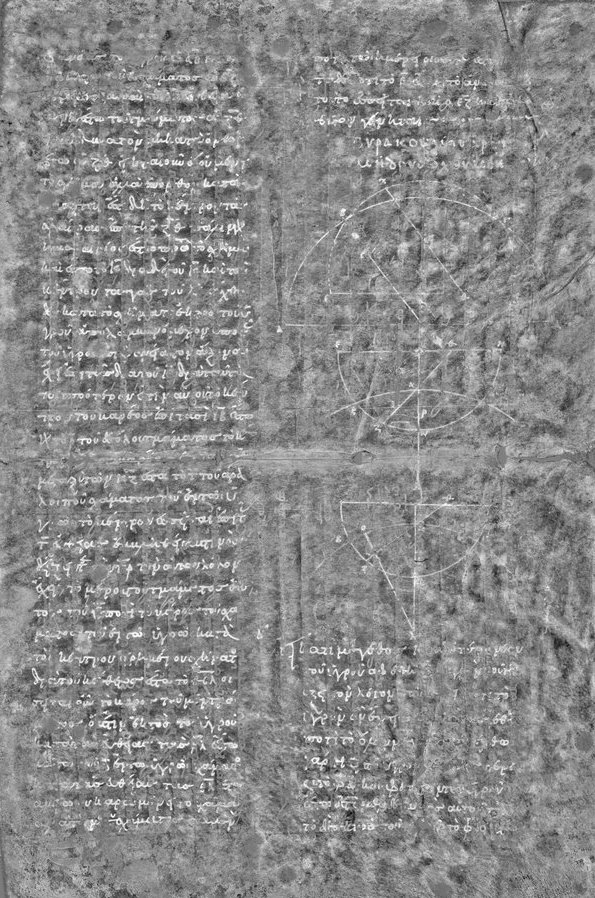Archimedes Palimset – Codex C

In this TED Talk, William Noel tells the fascinating story of how a text from Archimedes was found buried inside a medieval book of prayers.
Noel, who is curator of manuscripts and rare books at the Walters Art Museum, tells us how a passionate team of people from many different backgrounds worked together to recover the text and made all the intermediate and resulting information available online under a Creative Commons license.
This is one of only three text from Archimedes that have survived until modern times. Scholars refer to these books simply as Archimedes Codex A, B and C.
The text was found because a man named Johanness Maronass, wrote a book of prayers by using parchment that he recycled from seven…”old books;” one of which happened to be the Codex C from Archimedes. Johanness took the old books, disassembled them, washed out the ink, cut the pages in half, rotated them, wrote Orthodox Christian prayers on them, and bound the pages into a “new” medieval book, which he finished in 1229.
 |
 |
Left: Image of the Archimedes Palimpset as seen in normal light. Right: Same page after imaging, and image processing.
The Archimedes manuscript was written in the second half of the tenth century, almost certainly in Constantinople, and it includes seven treaties by Archimedes:
- The Equilibrium of Planes
- Spiral Lines
- The Measurement of the Circle
- Sphere and Cylinder
- On Floating Bodies
- The Method of Mechanical Theorems
- Stomachion
This copy of the treaty “On Floating Bodies” is the only surviving copy of this treaty in Greek – a remarkable fact when one remembers what Archimedes was doing when he exclaimed Eureka!
William Noel remarks that this is the kind of book that one would expect to find safely kept in a Museum, but that instead, it was bought by a private individual who wanted to make it available to all.
“He wanted to make that which was fragile, safe
He wanted to make that which was unique, ubiquitous
He wanted to make that which is expensive, Free.
..and he wanted to do this as a matter of Principle.”
because, although not many people are going to want to read the text of Archimedes in ancient Greek, they should have the chance to do it.
The owner of the book, after paying $2M for it in an auction, gathered a team of people “The Friends of Archimedes” to restore the text and study it, and he promised to pay for all the work of the team.
The cost of the study was not as high as one would expect,
“Because these people,
they didn’t came for money,
they came for Archimedes”
and the came from a great diversity of fields, including:
- Particle Physics
- Classical Philology
- Book Conservation
- Ancient Mathematics
- Data Management
- Scientific Imaging
- Program Management
The team imaged the manuscript in 14 different wavelengths of light in order to get as much data as they could, to be able to separate the original Archimedes text from the more recent medieval prayers, and to overcome the damage that centuries of passage of time had made to the book.
Additionally, since the medieval author also painted images on the pages as part of the book of prayers, the team had to also acquire images using X-Ray fluorescence using the facilities at the Stanford Synchrotron Radiation laboratory. The X-Ray illumination triggered fluorescence in the Iron atoms contained in the ink.
All these data, including the raw images, processed images and transcriptions, have been put online under a Creative Commons by Attibution 3.0 License, for anyone to use, even for any commercial purpose.
The owner of manuscript did this, because he understand the difference between Books and Data. If you want Data to be used, you have to to let it out, and let everyone have it with as few restrictions as possible.
William Noel then elaborates insightfully:
“…Institutions can learn from this,
because institutions at the moment
confine their data with Copyright restrictions…”
that prevents the effective utilization of the data.
“.. the World of Ancient Manuscripts of the future
is not going to be built by Institutions
it is going to be build by Users
by people who get this data together,
by people who want to aggregate all sort of maps
from wherever they come from…”
“People just want to curate their own glorious
selection of beautiful things and
that is the future of the Web and
it is an attractive and beautiful future,
if only we can make it happen.”
The Walters Museum has embraced this view of the future and now posts all its digital collection online under a Creative Commons by Attribution license.
Noel closes his talk win an inspirational vision of the future of the Web:
“I think that institutions should release all that data under unrestrictive licenses and it will be a great benefit for everybody, why don’t we just let everybody have access to this data and curate their own collection of ancient knowledge and wonderful and beautiful things and increase the beauty and the cultural significance of the Internet.”